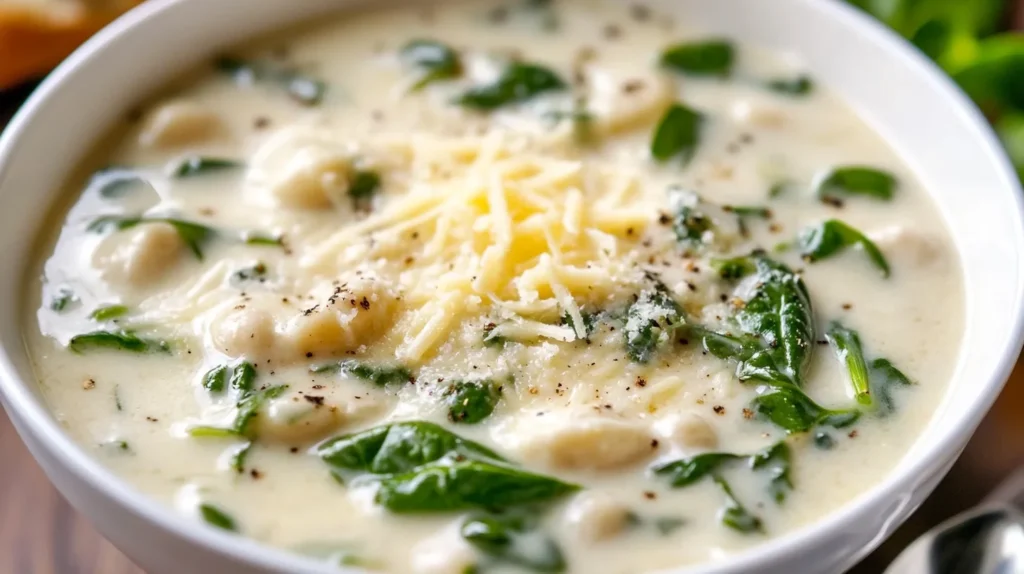When you think about adding parmesan cheese to your soup, you might wonder if it will melt. This is a common question for many who love soup. Knowing if parmesan melts can change how your soup tastes and feels.
Adding parmesan cheese to your soup can make it taste richer and creamier. But, you need to pick the right parmesan and add it at the right time. Melting cheese in soup can be tricky, but with some tips, you can make a delicious soup.
Exploring soups and parmesan cheese, you’ll find that the type of parmesan matters a lot. Whether you use freshly grated or pre-grated, it affects your soup’s taste and texture. So, will parmesan melt in soup? Yes, it can, depending on the parmesan and how you add it.
Related : Creamy Parmesan Italian Sausage Soup Recipe
Key Takeaways
- Understanding parmesan cheese’s melting properties is crucial for achieving the desired result in soup.
- Choosing the right type of parmesan cheese can significantly impact the flavor and texture of your soup.
- Adding parmesan cheese at the right time is essential for creating a creamy and delicious soup.
- Freshly grated parmesan cheese can make a big difference in the flavor and texture of your soup.
- Using parmesan cheese in soup can add flavor and creaminess to your dish.
- Melting cheese in soup can be a bit tricky, but with some tips and tricks, you can create a successful dish.
Understanding Parmesan Cheese’s Melting Properties
Using parmesan cheese in soup is a great choice because of its melting properties. It’s known for its rich flavor and creamy texture. But why is it the top choice for melting in soup? Let’s explore the science behind it.
Parmesan cheese melts well because of its chemical makeup. It melts between 120°F to 130°F (49°C to 54°C), perfect for soups. When heated, it melts, releasing its flavors and aromas.
Chemical Composition of Parmesan
Parmesan cheese is rich in casein, a milk protein. This protein makes it firm and granular. When heated, the casein breaks down, melting the cheese smoothly.
Heat Tolerance and Melting Point
Knowing parmesan’s heat tolerance and melting point is key. If the soup is too hot, the cheese can become too runny. If it’s not hot enough, it won’t melt right. Finding the right heat balance is crucial for a creamy, flavorful soup.

Different Forms of Parmesan
The form of parmesan cheese affects its melting. Grated or shredded parmesan melts better than sliced or block. Choosing the right form ensures a delicious, satisfying soup.
Will Parmesan Melt in Soup?
When it comes to will parmesan melt in soup?, the answer is yes, but it depends on the soup type and how you add the Parmesan. You can make tasty parmesan soup recipes with a creamy Parmesan texture. It’s important to know how Parmesan melts and how it works with different soups.
The soup’s temperature is key to whether Parmesan melts well. If it’s too hot, the Parmesan might not melt right, making it taste bad. If it’s too cold, it won’t melt at all. So, adding the Parmesan at the right temperature is crucial.
- Add the Parmesan towards the end of cooking to avoid it melting too fast.
- Use gentle heat to melt the Parmesan, as high heat can make it separate or become grainy.
- Stir the soup constantly to make sure the Parmesan melts evenly and spreads well.
By following these tips and knowing how Parmesan melts, you can make delicious and creamy parmesan soup recipes. Whether it’s a classic Italian soup or a creamy broth, Parmesan adds a rich flavor that makes the dish better.
| Soup Type | Parmesan Melting Properties |
|---|---|
| Cream-based soups | Melts easily and evenly |
| Broths and clear soups | |
| Thick and hearty soups | Melts slowly, may require additional heat |

Best Types of Parmesan for Soup Applications
Choosing the right parmesan cheese is key when making soup. You want it to melt well and add a rich flavor. Freshly grated or pre-grated parmesan are the main choices.
Freshly grated parmesan is often the top pick for soup toppings. It tastes more vibrant and has a smoother texture. Pre-grated parmesan is handy but might have additives that change the taste. The cheese’s age also matters. Younger cheese melts better and tastes milder, while older cheese has a nuttier taste and a crumblier texture.
Freshly Grated vs Pre-Grated
- Freshly grated parmesan has a more vibrant flavor
- Pre-grated parmesan can be more convenient but may contain additives
Age Considerations
The age of parmesan cheese affects its taste and texture in soup. Younger cheese is better for cooking, while older cheese is great for toppings.
Quality Indicators
For top-notch parmesan, look for cheese made from quality milk. It should have a rich, nutty taste. Stay away from processed cheese with additives, as they can ruin your soup’s flavor and texture.
| Type of Parmesan | Flavor | Texture |
|---|---|---|
| Freshly Grated | Vibrant, nutty | Smooth |
| Pre-Grated | Milder, may contain additives | Crumbly |
| Young Parmesan | Mild, creamy | Smooth |
| Old Parmesan | Nutty, sharp | Crumbly |
Proper Techniques for Adding Parmesan to Soup
Adding parmesan to soup is all about timing and amount. You want to enhance the flavor without overpowering it. Start by grating the cheese finely for even melting. Add it towards the end of cooking to blend smoothly.
Here are some tips for melting parmesan in soup:
- Use a low heat to avoid grainy cheese.
- Stir gently to spread the cheese evenly.
- Simmer for a few minutes to mix flavors.
Mastering parmesan in soup takes practice. Taste and adjust as you go. Try different parmesans to find your favorite.
| Cheese Type | Melting Point | Flavor Profile |
|---|---|---|
| Parmesan | 180-190°F | Nutty, sharp |
| Mozzarella | 130-140°F | Mild, creamy |
| Cheddar | 150-160°F | Sharp, tangy |
With these tips, you’ll make creamy soups with parmesan. Try classic Italian soups or new recipes. The goal is to experiment and find your perfect mix.
Common Mistakes When Using Parmesan in Soup
Using parmesan in soup can lead to mistakes that change the taste and feel of the dish. Knowing these errors helps you avoid them. One key thing is to add the parmesan at the right temperature.
Temperature Issues
Putting parmesan in soup at the wrong temperature stops it from melting right. It’s important to make sure the soup is warm enough for the cheese to melt well.
Timing Problems
Timing is also very important. Adding parmesan too soon or too late can mess up the taste and texture. You should add it when it will melt and mix well with the other ingredients.
Texture Concerns
Texture matters a lot when using parmesan in soup. If the cheese doesn’t melt right, it can make the soup feel bad. To fix this, stir the soup a lot when adding parmesan and make sure it’s mixed in well before serving.
Best Soup Types for Parmesan Cheese
Choosing the right soup type is key when using parmesan cheese. Creamy soups like broccoli or potato soup work great. They get even better with a parmesan topping.
Tomato-based soups, such as tomato bisque or creamy tomato soup, also pair well. The salty, savory taste of parmesan complements them perfectly. You can also add parmesan to broth-based soups like chicken or vegetable broth. It adds depth and flavor.
Some popular parmesan soup recipes include:
- Creamy broccoli soup with parmesan crust
- Tomato bisque with parmesan croutons
- Chicken noodle soup with parmesan topping for soup
These are just a few examples of delicious parmesan soup recipes. By picking the right soup and using parmesan, you can make a rich and satisfying soup. It’s sure to be a hit.
Creating Creamy Parmesan-Based Soup Bases
To make a delicious parmesan italian sausage soup, start with a solid base. You can make a basic cream base by mixing heavy cream, chicken or vegetable broth, and a bit of parmesan cheese in a saucepan.
As you heat the mix, add garlic, onion, and italian sausage to boost the flavor. For a richer taste, use a roux-based solution. This is made by mixing flour and butter to thicken the soup. It makes your parmesan soup creamy and rich.
Basic Cream Base
- Heavy cream
- Chicken or vegetable broth
- Parmesan cheese
Roux-Based Solutions
Adding a roux to your soup can make it more complex and tasty. By mixing flour and butter, you get a smooth, creamy texture. This texture goes well with the parmesan cheese.
Incorporating Other Cheeses
You can also try other cheeses in your parmesan soup. Mozzarella, gorgonzola, or feta cheese can add unique flavors. Mixing different cheeses creates a rich, creamy taste that makes your soup special.
Alternative Ways to Use Parmesan in Soups
Using parmesan cheese in soup isn’t just about melting it. You can also use it as a parmesan topping for soup. This adds a salty, nutty flavor. Or, you can add it to the soup base for a rich, creamy broth.
Here are some popular ways to use parmesan in soups:
- Using parmesan as a garnish, sprinkling it on top of the soup for added flavor and texture
- Adding parmesan to the soup base, creating a creamy and flavorful broth
- Making a parmesan sauce to serve on the side, perfect for dipping crusty bread
Parmesan cheese can really enhance your soup. It’s great in everything from minestrone to creamy tomato soup. Try different types of parmesan, like freshly grated or aged, to find your favorite.
When using parmesan in soups, balance the flavors and textures. A little creativity can make a delicious, satisfying soup. This will show off the rich flavor of parmesan cheese.
Experimenting with different techniques and ingredients can lead to a unique, delicious soup. Try adding parmesan topping for soup to your next dish. It’s a great way to add flavor and versatility.
| Soup Type | Parmesan Usage |
|---|---|
| Minestrone | Sprinkle parmesan on top as a garnish |
| Tomato Soup | Add parmesan to the soup base for a creamy broth |
| Creamy Broth | Use parmesan to make a rich and flavorful sauce |
Storing and Reheating Parmesan Soups
Cooking with parmesan in soup is a delicate art. To keep your parmesan soups fresh and tasty, follow the right storage and reheating methods.
Cooling parmesan soups quickly and refrigerating or freezing them fast is key. This step prevents bacteria growth and keeps the soup fresh longer.
Storage Guidelines
- Refrigerate parmesan soups at 40°F (4°C) or below within two hours of cooking.
- Freeze parmesan soups at 0°F (-18°C) or below for longer storage.
- Use airtight containers to prevent contamination and spoilage.
Reheating Methods
To reheat parmesan soups, use the stovetop, microwave, or oven. Always heat the soup to 165°F (74°C) to ensure it’s safe to eat.
Quality Preservation Tips
To keep your parmesan soups at their best, handle them carefully and avoid over-reheating. Adding fresh parmesan cheese or herbs can also boost the flavor and texture.
Troubleshooting Common Parmesan Melting Issues
Ever wonder will parmesan melt in soup?? It’s key to pick the right parmesan cheese. The cheese’s age, quality, and the soup’s temperature matter. For a smooth texture, choose wisely.
Here are some common issues when melting parmesan cheese in soup:
- Grainy texture: This can occur when the parmesan cheese is not grated finely enough or when it’s added to the soup at too high a temperature.
- Separation: This happens when the fat in the parmesan cheese separates from the liquid, resulting in an unappetizing texture.
- Insufficient melting: This can be caused by using a low-quality parmesan cheese or not heating the soup to the right temperature.
To fix these problems, try these tips:
- Use a high-quality parmesan cheese that’s freshly grated.
- Add the parmesan cheese to the soup at a low temperature, whisking constantly to prevent lumps from forming.
- Use a combination of parmesan cheese and other cheeses, such as mozzarella or ricotta, to achieve a creamy texture.
By following these tips, you can make a delicious, creamy soup. Remember to pick the right parmesan cheese and heat it correctly. If you’re still having trouble, try different cheeses or adjust the soup’s temperature.
Conclusion
Using Parmesan cheese in soups is a fun and rewarding experience. You now know how to pick the right Parmesan, when to add it, and how to avoid mistakes. Whether you’re into Parmesan soup recipes or just want to add a special touch to your favorite soup, the key is to experiment. Find what you like best.
Parmesan’s unique melting point and rich flavor make it perfect for many soups. It works well in creamy bisques and hearty stews. By using the tips from this article, you can easily add Parmesan to your soups. This will make them taste and feel better.
Start exploring the world of Parmesan cheese in soup and let your creativity flow. With the right techniques, you can turn simple soups into amazing dishes. Your family and friends will love them.
FAQ
Will Parmesan Melt in Soup?
Yes, Parmesan cheese can melt in soup. But how well it melts depends on the type of Parmesan and how it’s added. Handling the cheese right is key for a smooth soup.
What Factors Affect How Parmesan Melts in Soup?
The way Parmesan melts in soup depends on its chemical makeup, heat tolerance, and form. Freshly grated Parmesan melts better than pre-grated. Younger Parmesan also melts better than older, aged varieties.
What Are the Best Types of Parmesan for Soup Applications?
For the best melting, choose a freshly grated Parmesan that’s 12-18 months old. Avoid pre-grated Parmesan. Look for high-quality Parmesan with a creamy texture and nutty flavor.
How Do I Properly Add Parmesan to Soup?
Add Parmesan to hot soup just before serving. Stir gently in a circular motion. Avoid boiling the soup after adding Parmesan to prevent it from becoming stringy.
What Are Some Common Mistakes to Avoid When Using Parmesan in Soup?
Don’t add Parmesan too early or use low-quality cheese. Stir it gently. Avoid overheating the soup after adding Parmesan to prevent grainy cheese.
What Types of Soups Work Best with Parmesan Cheese?
Parmesan cheese is great in creamy soups, tomato-based soups, and broth-based soups. It’s delicious in creamy Parmesan-Italian sausage soup, minestrone, or chicken noodle soup.
How Can I Create a Creamy Parmesan-Based Soup Base?
Use a cream base, a roux-based solution, or other cheeses like Béchamel or Gruyère. Melt the Parmesan slowly and evenly for a rich, creamy soup base.
Are There Any Alternative Ways to Use Parmesan in Soups?
Yes, you can use Parmesan as a topping, mix it into the soup base, or make a creamy Parmesan sauce. These methods add flavor and texture to your soups.
How Can I Store and Reheat Parmesan Soups?
Store Parmesan soups in an airtight container in the fridge for 3-4 days. Reheat gently over medium heat, stirring constantly. Adding broth or cream helps the Parmesan melt smoothly.
How Can I Troubleshoot Common Parmesan Melting Issues?
For melting issues, use fresher, higher-quality Parmesan. Add it at the end and stir gently. Avoid high heat and prolonged boiling to prevent the cheese from seizing up.

